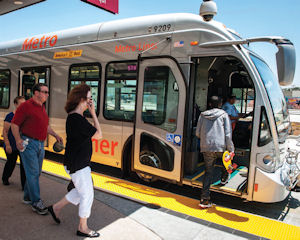With the opening of the Orange Line busway extension, workers in the west San Fernando Valley have another option in taking public transportation to their jobs. The four mile dedicated route with limited stops connects the Metrolink station in Chatsworth with Canoga Park. From there, the silver buses follow the existing busway to North Hollywood and the Red Line subway station. The opening weekend of June 30 and July 1 drew 11,000 boardings, according to Metro officials. But it remains to be seen whether the extension will fulfill its promise of providing reliable service for commuters. Some public transit advocates said the new service falls short because of lack of connections to other bus lines. Metro projects 9,000 daily boardings on the extension by 2030 and a daily ridership of 45,000 on the entire Orange Line by that same year, said Dave Sotero, an agency spokesman. “This should add a spark to the west San Fernando Valley interest of commuting options and in business and residential interest in living and working in that corridor,” Sotero said. In addition to the Metrolink stop, there also are stations at Sherman Way, Roscoe Boulevard, and Nordhoff Street. The Transit Coalition Executive Director Bart Reed was “delighted” with the extension, yet pointed out limitations regarding interconnectivity with other bus lines. He said those limitations could pose concerns for businesses located away from the Canoga corridor that have employees who rely on the bus to get to and from work. “They spent a lot of money in capital and left a lot on the table by not serving the public,” Reed said. The original Orange Line opened in October 2005 on a former railroad right-of-way to provide express bus service between North Hollywood and Warner Center. Within a year, Metro was already planning for the extension, which broke ground in 2009. The $153 million in funding came through Measure R, a ballot initiative passed in November 2008 to raise the sales tax a half cent to fund public transportation and highway projects. The project had originally been budgeted at $215 million. The project also includes the longest transit adjacent bike path in Los Angeles County where residents can ride, go for a walk and take their pets, Sotero said. “Aesthetically it’s much nicer than what was there before,” he said. Like the first phase of the Orange Line, the extension follows a one-time railroad property. Metro, however, had been leasing the land to about 86 businesses with all but four having to relocate once construction was ready to start. Now that the extension is open, efforts are underway to get passengers out of their cars and aboard the buses. Between 30,000 and 35,000 employees work within the boundaries of Warner Center, said Christopher Park, director of the Warner Center Transportation Management Organization, which works with the largest employers and property owners in Woodland Hills and Canoga Park. The organization has had conversations with corporate transportation coordinators and has made visits to multi-tenant buildings to promote the Orange Line. “We don’t get a new transit line opening every day,” Park said. “We want to aggressively reach out to the employees especially while it is new.” The Transit Coalition, a nonprofit public transportation advocacy group, has a different take on the Orange Line extension. Unlike the Warner Center TMO, the coalition sees its constituency as the blue-collar bus rider whose shift begins early in the morning or ends late at night, when bus service is limited, if available at all. “Some of the bus lines do not run on weekends or evenings,” Reed said. “What happens when you cannot get the last mile?” The coalition has contacted Metro directors to raise these issues and sought support from neighborhood councils for resolutions in support of additional service on bus lines feeding the Orange Line, as well as a station at Saticoy Street. A Saticoy station could increase ridership by 20 percent on the extension, Reed said, noting it would draw riders from a nearby community center, charter school, mental health facility and high density low-income housing. “The lack of fixing the final details will hold the Orange Line back,” he said. Sotero said Metro explored the possibility of a station at Saticoy but analysis showed that ridership numbers wouldn’t justify the move.
